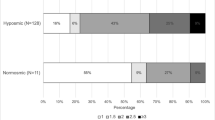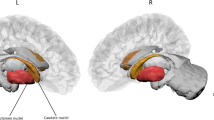Abstract
Olfactory dysfunction is a frequent and early feature of Parkinson’s disease (PD), often preceding the motor symptoms by several years. Assessment of olfactory deficits may be used in the diagnostic assessment of PD. In this study we investigated the relationship between selective deficits in smell identification and nigrostriatal dopaminergic denervation in patients with PD. Twenty-seven PD patients (Hoehn and Yahr stages I-III) and 27 healthy controls matched for gender and age underwent olfactory testing using the 40-odor University of Pennsylvania Smell Identification Test (UPSIT). PD patients underwent 11C-β-CFT dopamine transporter (DAT) positron emission tomography (PET) imaging and clinical motor examination. We found that total UPSIT scores were significantly lower in the PD than in the control subjects (z = 4.7, p < 0.0001). Analysis of the individual smell scores identified 3 odors with an accuracy of >0.75 for the diagnosis of PD. These odors were banana, licorice, and dill pickle. A PD-specific smell identification score (UPSIT-3) was calculated for these 3 odors. Analysis of the patient PET data demonstrated significant correlations between dorsal striatal DAT activity and the UPSIT-3 (RS = 0.53, p = 0.0027) and total UPSIT (RS = 0.44, p = 0.023) scores. UPSIT-3 (RS = 0.43, p = 0.027) but not total UPSIT (RS = 0.20, ns) correlated with nigral DAT activity. We conclude that patients with PD have selective hyposmia. A simplified UPSIT smell identification test consisting of 3 PD-selective odors had more robust correlation with nigral and dorsal striatial dopaminergic activity compared with the full UPSIT scores in patients with PD. Assessment of selective olfactory deficits may be used as a simplified olfactory screening test in the evaluation of subjects with possible PD.
Similar content being viewed by others
References
Berendse HW, Booij J, Francot CM, Bergmans PL, Hijman R, Stoof JC, Wolters EC (2001) Subclinical dopaminergic dysfunction in asymptomatic Parkinson’s disease patients’ relatives with a decreased sense of smell. Ann Neurol 50: 34–41
Bernheimer H, Birkmayer W, Hornykiewicz O, Jellinger K, Seitelberger F (1973) Brain dopamine and the syndromes of Parkinson and Huntington. Clinical, morphological and neurochemical correlations. J Neurol Sci 20: 415–455
Braak H, Del Tredici K, Rub U, de Vos RA, Jansen Steur EN, Braak E (2003) Staging of brain pathology related to sporadic Parkinson’s disease. Neurobiol Aging 24: 197–211
Braak H, Ghebremedhin E, Rub U, Bratzke H, Del Tredici K (2004) Stages in the development of Parkinson’s disease-related pathology. Cell Tissue Res 318: 121–134
Brooks D (1998) The early diagnosis of Parkinson’s disease. Ann Neurol 44(Suppl. 1): S10–S18
Chaudhuri KR, Yates L, Martinez-Martin P (2005) The non-motor symptom complex of Parkinson’s disease: a comprehensive assessment is essential. Curr Neurol Neurosci Rep 5: 275–283
Daum RF, Sekinger B, Kobal G, Lang CJG (2000) Riechprüfung mit “sniffin’ sticks” zur klinischen Diagnostic des Morbus Parkinson. Nervenarzt 71: 643–650
Davila NG, Blakemore LJ, Trombley PQ (2003) Dopamine modulates synaptic transmission between rat olfactory bulb neurons in culture. J Neurophysiol 90: 395–404
Doty RL, Deems DA, Stellar S (1988) Olfactory dysfunction in parkinsonism: a general deficit unrelated to neurologic signs, disease stage, or disease duration. Neurology 38: 1237–1244
Doty RL, Shaman P, Dann M (1984) Development of the University of Pennsylvania Smell Identification Test: a standardized microencapsulated test of olfactory function. Physiol Behav 32: 489–502
Doty RL, Shaman P, Kimmelman CP, Dann MS (1984) University of Pennsylvania Smell Identification Test: a rapid quantitative olfactory function test for the clinic. Laryngoscope 94: 176–178
Doty RL, Singh A, Tetrud J, Langston JW (1992) Lack of major olfactory dysfunction in MPTP-induced parkinsonism. Ann Neurol 32: 97–100
Doty RL, Stern MB, Pfeiffer C, Gollomp SM, Hurtig HI (1992) Bilateral olfactory dysfunction in early stage treated and untreated idiopathic Parkinson’s disease. J Neurol Neurosurg Psychiatry 55: 138–142
Double KL, Rowe DB, Hayes M, Chan DK, Blackie J, Corbett A, Joffe R, Fung VS, Morris J, Halliday GM (2003) Identifying the pattern of olfactory deficits in Parkinson disease using the brief smell identification test. Arch Neurol 60: 545–549
Fahn S, Elton R (1987) Members of the UPDRS development committee. Unified Parkinson’s disease rating scale. In: Fahn S, Marsden C, Calne D, Goldstein M (eds) Recent developments in Parkinson’s disease. Macmillan Healthcare Information, Florham Park, NJ, pp 153–164
Farley IJ, Price KS, Hornykiewicz O (1977) Dopamine in the limbic regions of the human brain: normal and abnormal. Adv Biochem Psychopharmacol 16: 57–64
Gelb DJ, Oliver E, Gilman S (1999) Diagnostic criteria for Parkinson disease. Arch Neurol 56: 33–39
Hack MA, Saghatelyan A, de Chevigny A, Pfeifer A, Ashery-Padan R, Lledo PM, Gotz M (2005) Neuronal fate determinants of adult olfactory bulb neurogenesis. Nat Neurosci 8: 865–867
Hawkes CH, Shephard BC (1993) Selective anosmia in Parkinson’s disease? Lancet 341: 435–436
Henderson JM, Lu Y, Wang S, Cartwright H, Halliday GM (2003) Olfactory deficits and sleep disturbances in Parkinson’s disease: a case-control survey. J Neurol Neurosurg Psychiatry 74: 956–958
Hoehn M, Yahr M (1967) Parkinsonism: onset, progression, and mortality. Neurology 17: 427–442
Hughes AJ, Daniel SE, Kilford L, Lees AJ (1992) Accuracy of clinical diagnosis of idiopathic Parkinson’s disease: a clinicopathologic study of 100 cases. J Neurol Neurosurg Psychiatry 55: 181–184
Huisman E, Uylings HB, Hoogland PV (2004) A 100% increase of dopaminergic cells in the olfactory bulb may explain hyposmia in Parkinson’s disease. Mov Disord 19: 687–692
Ichise M, Liow JS, Lu JQ, Takano A, Model K, Toyama H, Suhara T, Suzuki K, Innis RB, Carson RE (2003) Linearized reference tissue parametric imaging methods: application to [11C]DASB positron emission tomography studies of the serotonin transporter in human brain. J Cereb Blood Flow Metab 23: 1096–1112
Katzenschlager R, Lees AJ (2004) Olfaction and Parkinson’s syndromes: its role in differential diagnosis. Curr Opin Neurol 17: 417–423
Kish SJ, Shannak K, Hornykiewicz O (1988) Uneven pattern of dopamine loss in the striatum of patients with idiopathic Parkinson’s disease. N Eng J Med 318: 876–880
Koeppe RA, Holthoff VA, Frey KA, Kilbourn MR, Kuhl DE (1991) Compartmental analysis of [11C]flumazenil kinetics for the estimation of ligand transport rate and receptor distribution using positron emission tomography. J Cereb Blood Flow Metab 11: 735–744
Korten JJ, Meulstee J (1980) Olfactory disturbances in parkinsonism. Clin Neurol Neurosurg 82: 113–118
Lammertsma AA, Hume SP (1996) Simplified reference tissue model for PET receptor studies. Neuroimage 4: 153–158
Lehrner J, Brucke T, Kryspin-Exner I, Asenbaum S, Podreka I (1995) Impaired olfactory function in Parkinson’s disease. Lancet 345: 1054–1055
Mackinnon A (2000) A spreadsheet for the calculation of comprehensive statistics for the assessment of diagnostic tests and inter-rater agreement. Comput Biol Med 30: 127–134
McLean JH, Shipley MT (1988) Postmitotic, postmigrational expression of tyrosine hydroxylase in olfactory bulb dopaminergic neurons. J Neurosci 8: 3658–3669
Montgomery EBJ, Koller WC, LaMantia TJ, Newman MC, Swanson-Hyland E, Kaszniak AW, Lyons K (2000) Early detection of probable idiopathic Parkinson’s disease: I. Development of a diagnostic test battery. Mov Disord 15: 467–473
Montgomery EBJ, Lyons K, Koller WC (2000) Early detection of probable idiopathic Parkinson’s disease: II. A prospective application of a diagnostic test battery. Mov Disord 15: 474–478
Moore RY, Whone AL, McGowan S, Brooks DJ (2003) Monoamine neuron innervation of the normal human brain: an 18F-DOPA PET study. Brain Res 982: 137–145
Nagren K, Halldin C, Muller L, Swahn CG, Lehikoinen P (1995) Comparison of [11C]methyl triflate and [11C]methyl iodide in the synthesis of PET radioligands such as [11C]beta-CIT and [11C]beta-CFT. Nucl Med Biol 22: 965–979
Nagren K, Muller L, Halldin C, Swahn CG, Lehikoinen P (1995) Improved synthesis of some commonly used PET radioligands by the use of [11C]methyl triflate. Nucl Med Biol 22: 235–239
Ponsen MM, Stoffers D, Booij J, van Eck-Smit BL, Wolters EC, Berendse HW (2004) Idiopathic hyposmia as a preclinical sign of Parkinson’s disease. Ann Neurol 56: 173–181
Siderowf A, Newberg A, Chou KL, Lloyd M, Colcher A, Hurtig HI, Stern MB, Doty RL, Mozley PD, Wintering N, Duda JE, Weintraub D, Moberg PJ (2005) [99mTc]TRODAT-1 SPECT imaging correlates with odor identification in early Parkinson disease. Neurology 64: 1716–1720
Stern MB (2004) The preclinical detection of Parkinson’s disease: ready for prime time? Ann Neurol 56: 169–171
Tissingh G, Berendse HW, Bergmans P, DeWaard R, Drukarch B, Stoof JC, Wolters EC (2001) Loss of olfaction in de novo and treated Parkinson’s disease: possible implications for early diagnosis. Mov Dis 16: 41–46
Wang J, Eslinger PJ, Smith MB, Yang QX (2005) Functional magnetic resonance imaging study of human olfaction and normal aging. J Gerontol A Biol Sci Med Sci 60: 510–514
Weinhard K (1998) Applications of 3D PET. In: Bendriem B, Townsend DW (eds) The theory and practice of 3D PET. Kluwer Academic Publishers, Boston, pp 133–167
Winner B, Geyer M, Couillard-Despres S, Aigner R, Bogdahn U, Aigner L, Kuhn G, Winkler J (2006) Striatal deafferentation increases dopaminergic neurogenesis in the adult olfactory bulb. Exp Neurol 197: 113–121
Wiseman MB, Nichols TE, Woods RP, Sweeney JA, Mintun MA (1995) Stereotaxic techniques comparing foci intensity and location of activation areas in the brain as obtained using positron emission tomography (PET). J Nucl Med 36(suppl): 93p
Wolters EC, Francot C, Bergmans P, Winogrodzka A, Booij J, Berendse HW, Stoof JC (2000) Preclinical (premotor) Parkinson’s disease. J Neurol 247(Suppl2:II): 103–109
Woods RP, Mazziota JC, Cherry SR (1993) MRI-PET registration with automated algorithm. J Comput Assist Tomogr 17: 536–546
Wu Y, Carson RE (2002) Noise reduction in the simplified reference tissue model for neuroreceptor functional imaging. J Cereb Blood Flow Metab 22: 1440–1452
Acknowledgments
The authors thank our PET technologists for their skillful performance in data acquisition, cyclotron operators and chemists for their production of [11C]-β-CFT, and research assistants Larry Ivanco, Dana Ivanco, and Kurt Schimmel for assistance.
Author information
Authors and Affiliations
Corresponding author
Additional information
Study supported by NIH NS-019608.
Rights and permissions
About this article
Cite this article
Bohnen, N.I., Gedela, S., Kuwabara, H. et al. Selective hyposmia and nigrostriatal dopaminergic denervation in Parkinson’s disease. J Neurol 254, 84–90 (2007). https://doi.org/10.1007/s00415-006-0284-y
Received:
Accepted:
Published:
Issue Date:
DOI: https://doi.org/10.1007/s00415-006-0284-y




